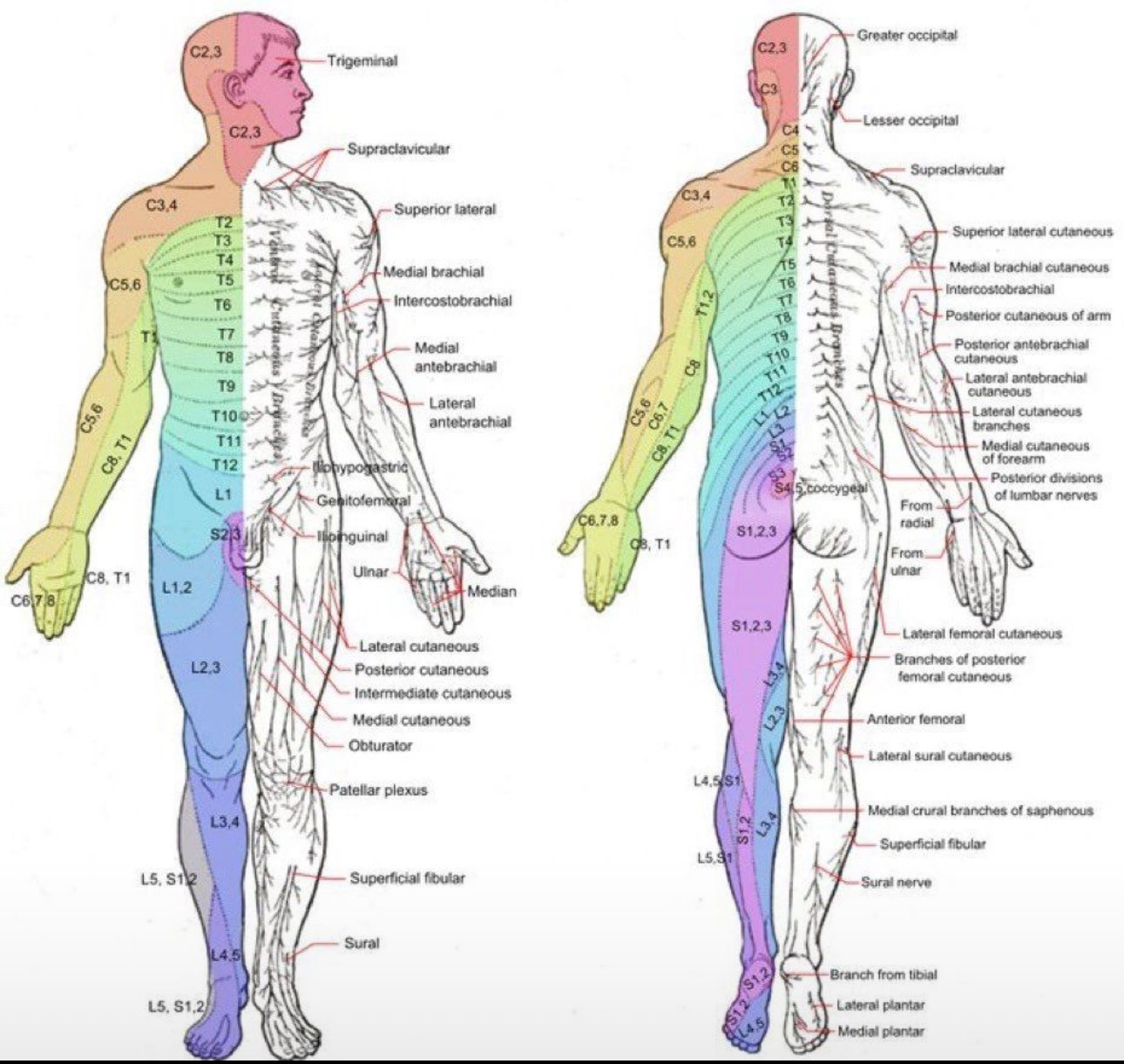THE INTELLIGENT TOUCH OF THE BODY: Understanding Sensory Nerves
Sensory Nerve Map of the body
The sensory nerves are an integral part of your peripheral nervous system. Their job is to collect information; such as temperature, pressure, pain, and touch; from the outer and inner environments of the body and transmit it to the central nervous system (CNS). But what many people don’t know is that sensory nerve activity is not uniform throughout the body. Instead, it adapts depending on its location and function.
Sensory Nerves by Region:
Skin: Detects pain, temperature, and light touch. Rich in free nerve endings and specialized receptors (like Merkel cells).
Joints and Muscles: Sense position, movement (proprioception), and tension; crucial for balance and coordination.
Internal Organs: Communicate subtle sensations (stretching, pressure, fullness) through visceral afferent fibers.
Face and Mouth: Linked to cranial nerves like the trigeminal nerve, these sensory fibers carry precise information about facial touch, pressure, and taste.
Each sensory input is localized and specialized, designed to support the needs of that body region and send detailed real-time updates to the brain.
THE CONNECTIVE INTELLIGENCE: What is Fascia?
Fascia is a three-dimensional web of connective tissue that surrounds and permeates every structure in the body; including muscles, organs, nerves, and blood vessels. It provides structure, support, and fluidity of movement, but more importantly, fascia is interwoven with sensory nerve endings.
According to the Journal of Bodywork and Movement Therapies (Schleip, 2003), fascia is richly innervated with proprioceptors and nociceptors, making it a key player in both movement and pain perception.
Fascia and the Nervous System: A Two-Way Communication
The sensory nerves within fascia continuously relay information to the brain about tension, movement, and pain. Fascia, when stiff or dehydrated, can compress nerves, leading to issues such as:
Chronic pain
Tingling or numbness
Poor posture
Reduced mobility
Likewise, an overstimulated or inflamed nervous system can lead to fascia tightening in a protective response, creating a feedback loop that influences both body and mood.
FASCIA, NERVES & DIGESTION: The Gut-Brain-Fascia Link
Did you know your fascia and nervous system affect digestion?
The vagus nerve, a primary parasympathetic nerve, passes through fascial planes in the neck, thorax, and abdomen.
If fascia around the diaphragm or gut is tight, it can impair vagal nerve function, leading to issues such as:
Bloating
Sluggish digestion
IBS-like symptoms
Emotional stress responses in the gut
Tight fascial tissue can alter gut motility and interrupt normal signaling to the brain, impacting mood, inflammation levels, and nutrient absorption.
DAILY SUPPORT: Holistic Practices to Nourish Your Fascia & Nervous System
To keep this intelligent system healthy, daily movement, breathwork, and nourishment are essential:
Movement & Stretches
Fascial Release Rolling: Use foam rollers or therapy balls along spine, hips, and thighs to gently hydrate and loosen fascia.
Cat-Cow Pose: Mobilizes spine and hydrates spinal fascia.
Lunges with Twists: Opens up fascia in hips and abdominal cavity.
Gentle Neck Stretches: Relieves fascial tension around the vagus nerve.
Dynamic Walking with Arm Swings: Stimulates proprioceptive nerves and warms up the whole fascial web.
Mind-Body Connection
Breathwork (Diaphragmatic Breathing): Enhances vagal tone, soothes the nervous system, and loosens fascia around the lungs and diaphragm.
Meditation or Sound Healing: Helps down-regulate nervous system activity and reset the fascia-nervous system relationship.
Nutrition & Hydration
Stay Hydrated: Fascia is mostly water-based; hydration maintains its elasticity and fluidity.
Magnesium-Rich Foods: (e.g., spinach, pumpkin seeds) calm the nervous system and relax tense fascia.
Herbs for Nerve and Fascia Health:
Ashwagandha: Calms the nervous system.
Gotu Kola: Supports connective tissue regeneration.
Turmeric: Reduces inflammation in fascia and nerves.
Chamomile & Lemon Balm: Gentle nervines that ease tension.
ADDITIONAL FASCIA & NERVOUS SYSTEM EFFECTS
Beyond digestion, this partnership influences:
Posture & Balance
Emotional Health (via somatic memory stored in fascia)
Sleep Regulation
Pain Sensitivity
Flexibility and Physical Performance
Hormonal Balance (fascia supports glands and vessels that secrete hormones)
Fascia is not just tissue; it’s a sensory organ, deeply involved in how we feel, move, and heal.
REFERENCES
Schleip, R. (2003). Fascial plasticity – A new neurobiological explanation: Part 1. Journal of Bodywork and Movement Therapies, 7(1), 11–19.
Willard, F. H., Vleeming, A., Schuenke, M. D., Danneels, L., & Schleip, R. (2012). The thoracolumbar fascia: Anatomy, function and clinical considerations. Journal of Anatomy, 221(6), 507–536.
Myers, T. (2020). Anatomy Trains: Myofascial Meridians for Manual and Movement Therapists.
Langevin, H. M., & Yandow, J. A. (2002). Relationship of acupuncture points and meridians to connective tissue planes. The Anatomical Record, 269(6), 257–265.
Porges, S. W. (2007). The polyvagal perspective. Biological Psychology, 74(2), 116–143.
